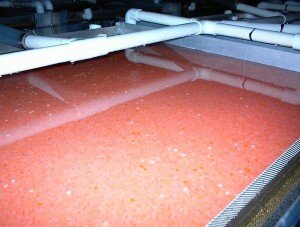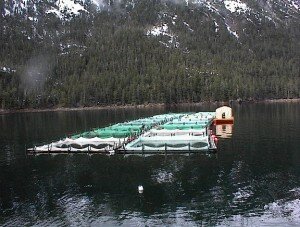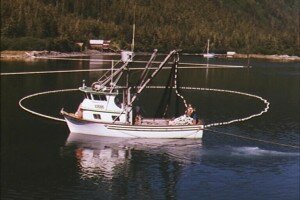Yesterday, the huge retail U.S. giant Target announced that it was dropping all farmed salmon from its fresh, frozen, and smoked seafood sections nationwide. See the Vancouver Sun article . Target has almost 1750 stores in 49 states in the U.S.
Target suggests they are moving to “wild-caught” Alaskan salmon.
This story suggests market pressures by many salmon farm opponents – at least open pen fish farming – is working. This is highlighted in the Sun article with quotes from the Monterrey Bay Aquarium, which suggests they worked with:
the retailer on changing its salmon offerings, stocking seafood from “ocean-friendly sources” [will] help improve fishing and fish-farming practices around the world.
One of the first things that peaked my curiosity – why does Target say “wild-caught” Alaskan salmon instead of just “wild salmon”?
Alaska has a ban on “fin fish farming” – so no fish farms… Yet, Alaska has a practice that is not fish “farming” but fish “ranching”.
Salmon ranching is a very common practice around the Pacific Rim – especially Japan and Korea. What’s the difference between salmon ranching and salmon farming?
It’s like the difference between feed lots for cattle and range-raised cattle.
Feed lots raise cattle in enclosed pens before being slaughtered. Range raised cattle feed in pastures before being slaughtered.
The pasture for salmon ranching?
The North Pacific ocean.
If you aren’t familiar with salmon ranching – Google it – or here’s the premise: raise salmon fry in a hatchery environment. This means catching adult salmon, put the female eggs in a bucket, put the male milt in the bucket with the eggs. Stir. Then incubate eggs in hatchery.
When eggs hatch, raise baby salmon in metal troughs. When big enough place them in net pens near the mouths of streams or in bays. Feed them pellets (like salmon farming) made from other fish. Release the baby salmon when they’re ready to “compete” with wild salmon. Instinct then kicks in; they migrate out to the ocean – or pasture.
Theory being that these baby salmon will be imprinted with the freshwater streams in the bay and return after their migration through the North Pacific (the pasture). When they return a few years later, catch them like any other salmon in commercial or sport fisheries – or indigenous fisheries.
This is the best ranching program going – no fixing broken fences, no wrangling, no shooting wolves… And no bad movies like City Slickers…
Image of an actual salmon ranching focussed seine fishery in Alaska:
Here’s a graph of Alaskan salmon catches from 1878-2003 (compliments of Alaska Dept. of Fish and Game):
 Apologies for the small print – the peak numbers are in the range of 200-215 million salmon caught in commercial fisheries at the peak in the 1990s.
Apologies for the small print – the peak numbers are in the range of 200-215 million salmon caught in commercial fisheries at the peak in the 1990s.
Numbers for 2008 suggest a total commercial catch of just over 146 million salmon.
Estimates of hatchery- or salmon ranched fish – or enhanced salmon as Alaska calls them – caught in commercial fisheries suggest ranges between 25% – 35% every year. There are almost 40 hatcheries – or salmon ranching – facilities in Alaska. In Prince William Sound (remember Exxon Valdez?) over 90% of the commercial catch of approximately 50 million salmon are from salmon ranching facilities (compliments of Alaska ).
So yes, these fish are “wild-caught”. But “ocean friendly” Monterrey Aquarium?
Is there a big difference here than say…. opening up the Atlantic salmon net pens in the Georgia Strait, catching them in a seine fishery, and then calling them “wild-caught” salmon?
Or what if we released the Monterrey Bay Aquarium’s captive bluefin tuna into Monterrey Bay for a “wild caught” tuna fishing derby?
Or, how about that hippo that escaped a zoo in Montenegro the other day (due to flooding) – when they captured that hippo was it “wild” or “wild caught”?
Hatcheries are very capital intensive projects – meaning lots of $$ to operate – especially when the State of Alaska is pumping out in the neighborhood of 1.5 billion salmon smolts from salmon ranching (or enhancement) facilities.
Japan releases almost 2 billion salmon smolts. Number aren’t known for Korea (as far as I can tell).
Current estimates suggest in the range of 5 billion salmon smolts from “enhancement” facilities head out to pasture (the North Pacific) every year. (British Columbia provides almost 600 million of those through the BC Salmon Enhancement Program). These “enhanced” fish compete with “wild” fish for what scientists suggest are dwindling resources in areas of the North Pacific. Plus these “enhanced” fish also need to be fed fish in pens. That feed comes from other fish, caught somewhere and ground into pellets.
Language is important. There is another type of “enhancement” options out there – and I suppose one could call this the difference between the “wild caught” breasts – prevalent in Hollywood – and “wild” breasts.
Or “natural” and “enhanced”.
Great to drop the farmed fish, I don’t touch it – but green washing the real story… “Ocean-friendly”… come on.






My craving for salmon went down a great deal after seeing the insides of one being poured into a bucket…